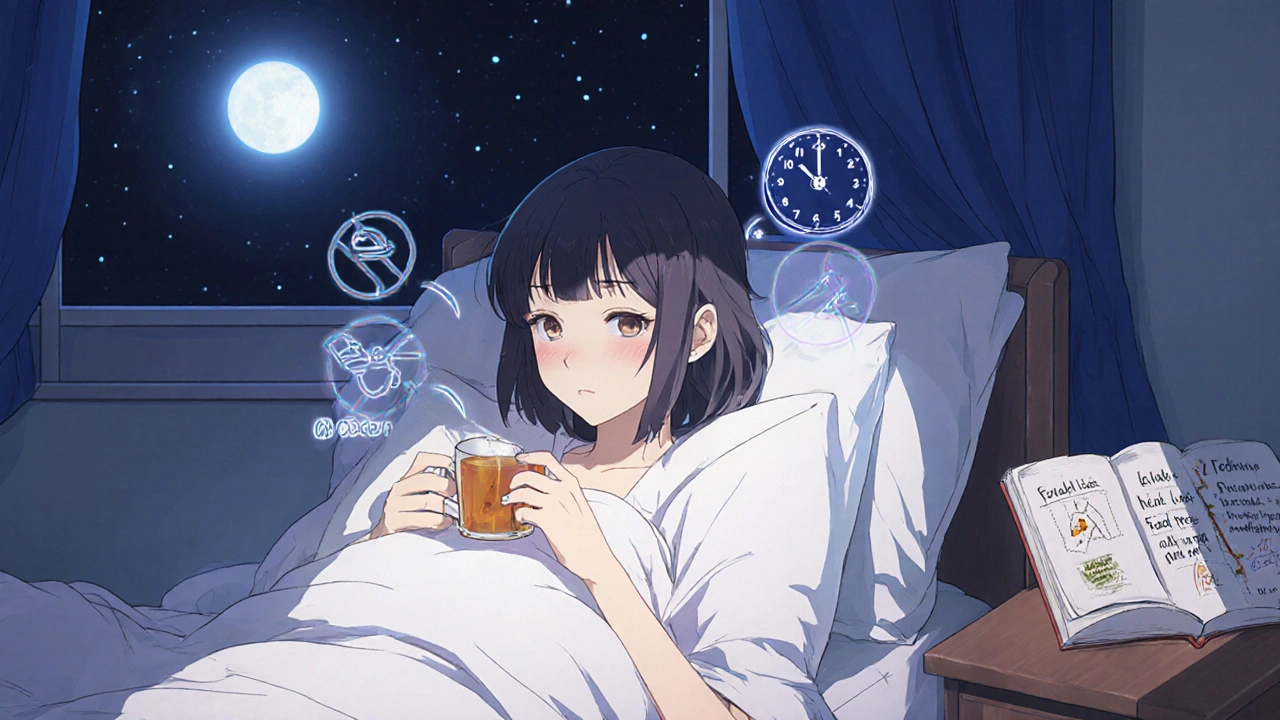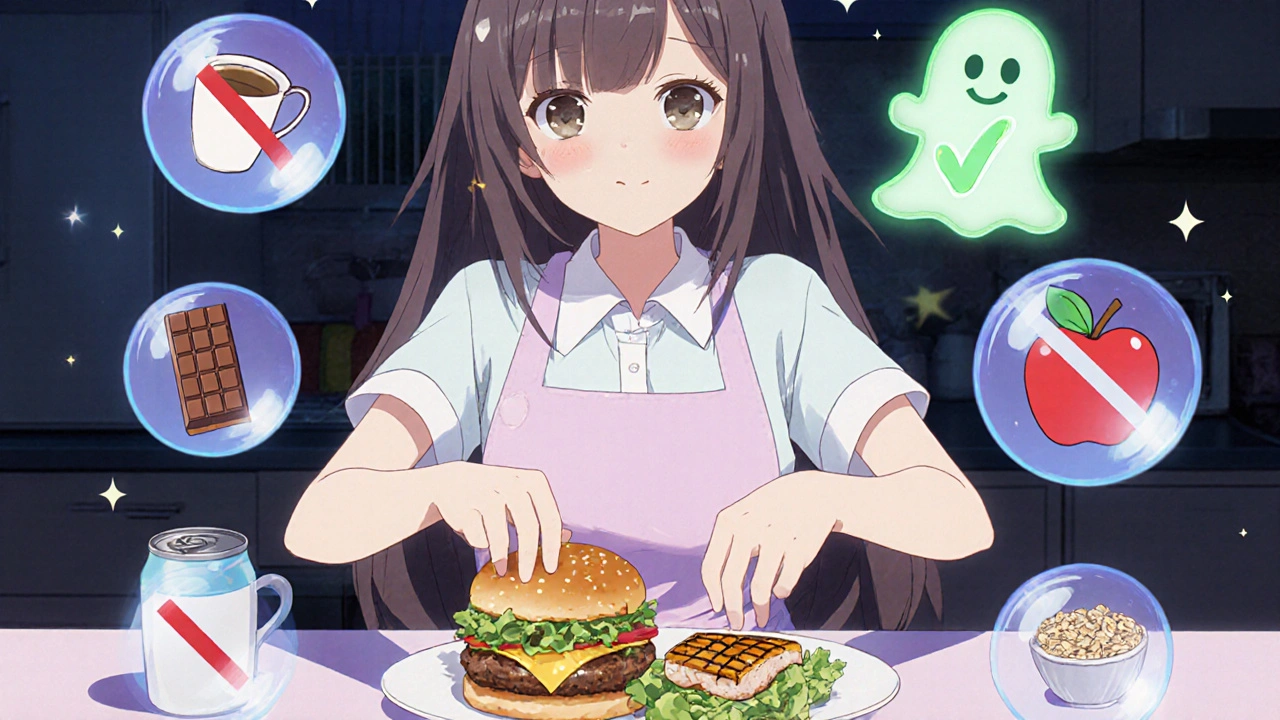GERD Management: Diet, Lifestyle, and Acid Reflux Medications
 Nov, 16 2025
Nov, 16 2025
What Is GERD, and Why Does It Keep Coming Back?
If you’ve ever felt that burning sensation rising from your stomach into your chest-especially after eating or lying down-you’re not alone. About 20% of people in the U.S. deal with gastroesophageal reflux disease, or GERD, on a regular basis. It’s not just occasional heartburn. GERD means stomach acid keeps flowing back into your esophagus, often more than twice a week, and it can damage the lining over time. Left untreated, it can lead to Barrett’s esophagus, a condition that slightly increases the risk of esophageal cancer.
The good news? Most people can get GERD under control without surgery. The key is understanding what triggers it and how to stop it at each stage-from simple lifestyle tweaks to powerful medications and, if needed, procedures like LINX or fundoplication.
Stage One: Fix Your Habits Before You Reach for Pills
Before you open a bottle of antacids, start here: your daily routine. Lifestyle changes are the first and most effective step in managing GERD, according to guidelines from the American College of Gastroenterology. For many, they’re enough.
- Elevate your head while sleeping. Use blocks under the bedposts or a wedge pillow to raise your upper body by six inches. Gravity helps keep acid where it belongs. Lying flat right after eating? That’s a recipe for nighttime reflux.
- Avoid eating within three hours of bedtime. Your stomach is still digesting when you lie down. Waiting just three hours cuts reflux episodes by over half.
- Quit smoking. Smoking weakens the lower esophageal sphincter (LES)-the valve that keeps acid in your stomach. Within 20 minutes of a cigarette, LES pressure drops by 30-40%.
- Watch your weight. Every 10% of body weight lost leads to a 40% drop in GERD symptoms. Extra belly fat presses on your stomach, forcing acid upward.
- Limit alcohol. Even two drinks a day can lower LES pressure by 25%. Beer and wine are especially problematic.
These aren’t just vague suggestions-they’re backed by clinical data. A 2023 Cleveland Clinic study showed that people who stuck to these changes saw symptom improvement even without medication.
What to Eat (and What to Skip)
Not all foods trigger GERD the same way for everyone-but some are almost universal troublemakers.
- Coffee and tea. Caffeine increases stomach acid production by 23% within 30 minutes. Decaf isn’t always safer-some decaf still triggers reflux.
- Chocolate. It contains methylxanthine, which relaxes the LES. Even a small piece can cause problems.
- Fatty foods. Meals with more than 30 grams of fat delay stomach emptying by 40-60 minutes, giving acid more time to back up. That burger, fried chicken, or creamy pasta? They’re not just heavy-they’re reflux triggers.
- Peppermint and spearmint. These herbs relax the LES. Mint tea might feel soothing, but it’s making your reflux worse.
- Citrus fruits and juices. Oranges, lemons, grapefruit-these are highly acidic (pH 2.0-4.0) and directly irritate the esophagus.
- Tomato-based products. Pasta sauce, salsa, ketchup-they’re acidic and often contain added sugar, which can worsen reflux.
- Carbonated drinks. Soda, sparkling water, and energy drinks inflate your stomach, increasing pressure and forcing acid upward.
Spicy foods don’t cause GERD, but they make your esophagus more sensitive to acid. If you’re already burning, hot sauce will make it worse.
Try keeping a food diary for two weeks. Write down what you eat, when you eat it, and how you feel an hour later. Most people find 2-3 specific triggers. Eliminate those first. You don’t need to cut out everything at once.

Medications: From Antacids to P-CABs
If lifestyle changes aren’t enough, medications step in. They’re grouped in stages, based on severity.
Over-the-Counter Antacids (Tums, Rolaids)
These neutralize acid fast-within minutes-but the relief lasts only 30-60 minutes. Great for occasional heartburn, not for daily GERD. Overuse can cause diarrhea or constipation.
H2 Blockers (Pepcid, Zantac)
These reduce acid production by 60-70%. Famotidine (Pepcid) starts working in about an hour and lasts 10-12 hours. Useful for mild symptoms or as a backup if you forget your PPI. But they’re not strong enough for erosive esophagitis.
Proton Pump Inhibitors (PPIs): The Gold Standard
PPIs are the go-to for moderate to severe GERD. They block 90-98% of acid production. Common ones include:
- Esomeprazole (Nexium)
- Lansoprazole (Prevacid)
- Omeprazole (Prilosec)
- Pantoprazole (Protonix)
- Rabeprazole (Aciphex)
- Dexlansoprazole (Dexilant)
Take them 30-60 minutes before your first meal of the day. That’s when your stomach’s acid pumps are most active. Taking them after eating? You’ll get far less benefit.
Most people feel better in 2-5 days. Full healing of esophagitis takes 8 weeks. Studies show PPIs heal erosive esophagitis in 80-90% of cases.
But long-term use has risks. The FDA warns that using PPIs for more than a year may raise your risk of:
- Community-acquired pneumonia (15-20% higher risk)
- Clostridium difficile infection (30% higher risk)
- Chronic kidney disease (10-15% higher risk)
- Magnesium and vitamin B12 deficiency
That’s why doctors recommend using the lowest effective dose for the shortest time possible.
Newer Option: Potassium-Competitive Acid Blockers (P-CABs)
Voquezna (vonoprazan), approved by the FDA in December 2023, is the first P-CAB for GERD. It works faster and more completely than PPIs. In clinical trials, 95% of patients maintained stomach pH above 4 for a full 24 hours-compared to just 65% with standard PPIs.
It’s especially helpful for nighttime reflux, which affects 70% of PPI users. Voquezna is now approved for both short-term and long-term use, making it a game-changer for people who don’t respond well to PPIs.
Surgery: When Medications Aren’t Enough
If you’ve tried lifestyle changes and medications for months-and you’re still having symptoms-surgery might be the next step. About 10-15% of GERD patients end up here.
Laparoscopic Nissen Fundoplication
This is the most common surgery. The surgeon wraps the top of your stomach around your lower esophagus to strengthen the LES. Success rate? 90-95% at five years.
But there are trade-offs:
- 5-10% chance of trouble swallowing (dysphagia)
- 15-20% risk of gas-bloat syndrome-you can’t burp or belch easily
- Can’t have an MRI after the procedure if metal clips were used
LINX Reflux Management System
Approved in 2012 and updated in 2020, LINX is a small bracelet of magnetic titanium beads implanted around the LES. It opens to let food through and snaps shut to block acid.
Benefits:
- 85% of patients stop daily PPIs after five years
- Only 2-3% need reoperation
- Quick recovery-most go home the next day
Drawbacks:
- Can’t have an MRI
- Not for people who’ve had prior stomach surgery
- 22% of users report persistent gas or bloating
Trustpilot reviews show 78% positive ratings. People love being off meds-but some still struggle with swallowing pills or feeling full too fast.
Transoral Incisionless Fundoplication (TIF)
This newer, endoscopic procedure rebuilds the valve from the inside using a special device. No incisions. Recovery is faster.
Success rate: 70-75% at three years. But only 127 doctors in the U.S. are certified to do it as of January 2025. It’s not widely available yet.
What Experts Say About Long-Term Control
Dr. Stuart Spechler from UT Southwestern says: “PPIs work great for erosive esophagitis, but 30-40% of patients have non-erosive GERD. Their symptoms come from nerve sensitivity, not just acid. That means diet and stress management matter just as much.”
On the other hand, Dr. Lauren Gerson from Stanford argues: “For patients with documented acid reflux, surgery gives better long-term results. Ten years out, 85% of surgical patients are symptom-free. Only 45% of those on meds are.”
So who’s right? Both. It depends on your body, your symptoms, and your goals.
If you want to avoid lifelong pills and your reflux is severe, surgery might be worth it. If you’re okay with a daily pill and your symptoms are mild to moderate, medication plus lifestyle changes will likely work.

Real People, Real Results
Reddit’s r/GERD community has over 140,000 members sharing what works. One user, u/HeartburnWarrior, wrote: “I cut fat to under 20g a day and raised my bed. No meds. Zero symptoms for 18 months.”
Another, u/AcidRefluxSufferer, tried PPIs for five years-then they stopped working. “I got LINX. Two years later, I’m free from daily pills and can eat pizza again.”
But not everyone has success. On Amazon, 19% of omeprazole reviews mention diarrhea. 12% report fatigue or B12 deficiency. Side effects are real-and they’re why many look for alternatives.
What’s Next for GERD Treatment?
The global GERD market hit $7.2 billion in 2023. PPIs make up 65% of that. But Voquezna (vonoprazan) is growing fast-120,000 new prescriptions in just six months after its 2023 approval.
As obesity rates climb (projected to hit 47% of U.S. adults by 2030), GERD cases will rise too. The American College of Gastroenterology is updating its guidelines in November 2025, with new focus on non-acid reflux and personalized diets.
One thing’s clear: GERD isn’t just about acid. It’s about pressure, sensitivity, timing, and habits. The best treatment isn’t one thing-it’s a combination.
Quick Action Plan
Here’s how to start today:
- Stop eating 3 hours before bed.
- Elevate your head while sleeping.
- Write down everything you eat for two weeks. Look for patterns.
- Cut out the big three: caffeine, fatty foods, and alcohol.
- If symptoms continue, see a doctor. Don’t self-medicate with PPIs long-term.
- If meds don’t help after 3 months, ask about surgery options like LINX.
GERD doesn’t have to control your life. With the right mix of habits, medicine, and sometimes surgery, you can eat, sleep, and live without that burning feeling.

Elizabeth Grant
November 17, 2025 AT 09:29Kamal Virk
November 18, 2025 AT 20:56LaMaya Edmonds
November 20, 2025 AT 03:32Monika Wasylewska
November 20, 2025 AT 04:51Attila Abraham
November 21, 2025 AT 19:02Michelle Machisa
November 22, 2025 AT 12:41Shawn Jason
November 22, 2025 AT 19:23See Lo
November 24, 2025 AT 02:02Jackie Burton
November 25, 2025 AT 10:34angie leblanc
November 25, 2025 AT 14:37Chris Long
November 25, 2025 AT 16:34Liv Loverso
November 26, 2025 AT 05:08Steve Davis
November 26, 2025 AT 22:56Ronald Thibodeau
November 27, 2025 AT 13:19